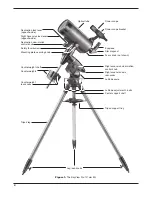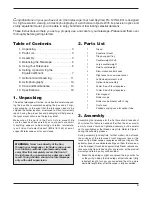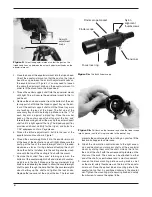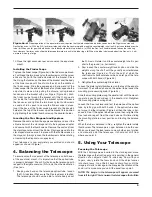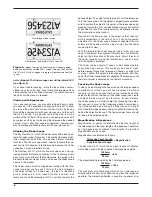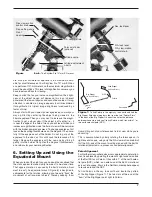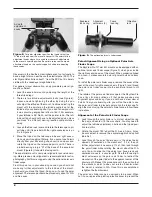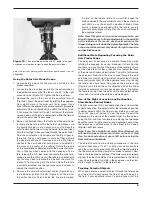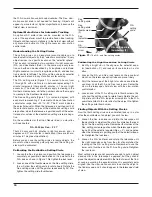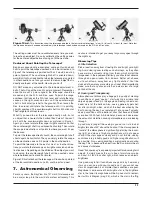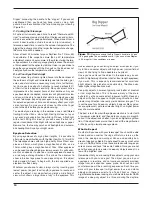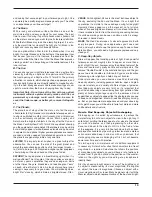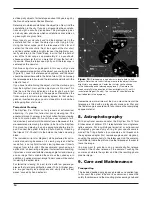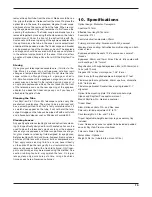
Observers in the Southern Hemisphere aren’t so fortunate to
have a bright star so near the south celestial pole (SCP). The
star Sigma Octantis lies about 1° from the SCP, but it is barely
visible with the naked eye (magnitude 5.5).
For general visual observation, an approximate polar align‑
ment is sufficient.
1. Level the equatorial mount by adjusting the length of the
three tripod legs.
2. There are two latitude adjustment L‑bolts (see Figure 6);
loosen one while tightening the other. By doing this you
will adjust the latitude of the mount. Continue adjusting the
mount until the pointer on the latitude scale is set at the
latitude of your observing site. If you don’t know your lati‑
tude, consult a geographical atlas to find it. For example,
if your latitude is 35° North, set the pointer to 35. The lati‑
tude setting should not have to be adjusted again unless
you move to a different viewing location some distance
away.
3. Loosen the Dec. lock lever and rotate the telescope’s opti‑
cal tube until it is parallel with the right ascension axis, as
it is in Figure 6.
4. Move the tripod so the telescope tube and right ascen‑
sion axis point roughly at Polaris. If you cannot see Polaris
directly from your observing site, consult a compass and
rotate the tripod so the telescope points north. There is
a label bearing a large “N” at the base of the equatorial
mount (Figure 8); it should be facing north.
The equatorial mount is now polar aligned for casual observ‑
ing. More precise polar alignment is recommended for astro‑
photography. For this we suggest using the optional polar axis
finder scope
From this point on in your observing session, you should not
make any further adjustments to the latitude of the mount,
nor should you move the tripod. Doing so will undo the polar
alignment. The telescope should be moved only about its R.A.
and Dec. axes.
Polar alignment using an optional Polar axis
Finder scope
The SkyView Pro 127mm EQ mount can be equipped with an
optional polar axis finder scope (Figure 9) which goes inside
the right ascension axis of the mount. When properly aligned
and used, it makes accurate polar alignment quick and easy
to do.
To install the polar axis finder scope, remove the cover at the
rear of the mount’s right ascension axis (Figure 9) and thread
the polar axis finder scope into the equatorial mount until
tight.
The reticle of the polar axis finder scope for the SkyView Pro
has a tiny star map printed on it that makes precise polar
alignment quick and easy. If you do not have a clear view of
Polaris from your observing site, you will not be able to use
the polar‑axis finder to precisely polar align the telescope. To
align the mount using the polar axis finder scope, follow these
instructions:
alignment of the Polar axis Finder scope
1. Look through the polar finder at a distant object (during
the day) and center it in the crosshairs. You may need to
adjust the latitude adjustment L‑bolts and the tripod posi‑
tion to do this.
2. Rotate the mount 180º about the R.A. axis. Again, it may
be convenient to remove the counterweights and optical
tube first.
3. Look through the polar finder again. Is the object being
viewed still centered on the crosshairs? If it is, then no
further adjustment is necessary. If not, then look through
the polar finder while rotating the mount about the R.A.
axis. You will notice that the object you have previously
centered moves in a circular path. Use the three align‑
ment setscrews on the polar axis finder to redirect the
crosshairs of the polar finder to the apparent center of this
circular path. Repeat this procedure until the position that
the crosshairs point to does not rotate off‑center when
the mount is rotated in R.A. Once this is accomplished,
retighten the thumbscrews.
The polar axis finder scope is now ready to be used. When
not in use, replace the plastic protective cover to prevent the
8
Figure 8.
For polar alignment, position the tripod so that the
"N" label at the base of the mount faces north. The azimuth fine
adjustment knobs above it are used to make small adjustments
to the mount’s azimuth position. Be certain to loosen the tripod
attachment knob on the central support shaft before adjusting
these knobs.
Azimuth
adjustment
knobs
Figure 9.
The optional polar axis finder scope.
Eyepiece
focus ring
Focus
lock‑ring
Objective
lens
Alignment
setscrews (3)


